Carnets de Géologie [Notebooks on Geology], vol. 14, nº 11 (Letter)
Contents
[Introduction] [Material and methods] [Microfacies types]
[Micropaleontological assemblage and age ...] [Regional comparison]
[Conclusion]
and ... [Bibliographic references]
Babeş-Bolyai
University, Department of Geology and Center for Integrated Geological Studies,
str. M. Kogălniceanu nr. 1, 400084 Cluj-Napoca (Romania)
Babeş-Bolyai University, Department of Geology and Center for Integrated Geological Studies, str. M. Kogălniceanu nr. 1, 400084 Cluj-Napoca (Romania)
Published online in final form (pdf) on July 3, 2014
[Editor: Bruno ; language
editor: Phil ]
Triassic, Upper Jurassic and upper Lower Cretaceous sedimentary formations were previously studied from the Transylvanian Depression basement, but the presence of lowermost Cretaceous (Berriasian-Valanginian) has not been confirmed paleontologically. The carbonate sequence cored from a borehole drilled in the central part of the Transylvanian Depression yields microfossil assemblages dominated by benthic foraminifera. These new data unequivocally document the presence of characteristic Berriasian-Valanginian taxa in these deposits.
Benthic foraminifera; biostratigraphy; Berriasian; Valanginian; Transylvanian Depression; Romania.
I.I., A., E., S. & R. (2014).- First record of lowermost Cretaceous shallow-water limestones in the basement of the Transylvanian Depression (Romania).- Carnets de Géologie [Notebooks on Geology], Brest, vol. 14, nº 11, p. 199-210.
Première identification en subsurface de calcaires d'eaux peu profondes attribués au Crétacé basal dans la Dépression de Transylvanie (Roumanie).- Les formations sédimentaires du Trias, du Jurassique supérieur et du Crétacé inférieur non basal ont été précédemment étudiés dans le substratum de la Dépression transylvanienne, mais la présence de Crétacé basal (Berriasian-Valanginian) n'avait pas été démontré paléontologiquement jusqu'à présent. La série carbonatée reconnue dans des carottes provenant d'un forage réalisé dans la partie centrale de la Dépression de Transylvanie recèlent des associations micropaléontologiques dominées par les foraminifères benthiques. Ces données nouvelles témoignent de la présence indubitable de taxons caractéristiques de l'intervalle Berriasien-Valanginien.
Foraminifères benthiques ; biostratigraphie ; Berriasien ; Valanginien ; Dépression de Transylvanie ; Roumanie.
The
Transylvanian Depression, surrounded by the Eastern Carpathians on the north and
east, the Southern Carpathians to the south, and the Apuseni Mountains and Ţicău-Preluca
heights to the west and north-west (Fig. 1 ![]() ), consists of a sedimentary succession
with important natural gas reserves in the Miocene sediments. Older sedimentary
formations (mainly Mesozoic, but also Paleogene) are present in the basement,
but have only briefly been documented, based on core samples recovered from several
deep wells (
& , 1967; et al.,
1970; , 1975,
1979; & ,
1978;
& , 2006; & ,
2008).
According to these authors, Permian-Triassic (conglomerates, marls, clays,
limestones and dolomites), Jurassic (limestones and dolomites assigned to the
Upper Jurassic), and Lower Cretaceous (Barremian-Albian marls, clays, sandstones,
microconglomerates, and limestones) formations were identified in the deep
boreholes, overlying Paleozoic metamorphites or Mesozoic volcanics. These
Permian to Lower Cretaceous deposits are in turn overlain by Upper Cretaceous (mainly siliciclastic turbidites), Paleogene
(siliciclastics and carbonates), and Miocene (siliciclastics) sediments that were interpreted as
integral components of the Transylvanian Depression ( et
al., 1970; & ,
2006). The structure of the
Transylvanian
basement was influenced by the same Cretaceous tectogenetic stages that were
responsible for emplacement of the Transylvanian Nappes in the Eastern Carpathians and
of some nappes in the
Apuseni Mountains ( & ,
1978; ,
1984). et al.
(2009, Table 1)
provide data on the boreholes that penetrated the Upper Jurassic and Lower Cretaceous carbonate deposits: 4501
Band, 6042 Deleni and 1 Cenade, at depths between 3100 and 4700 m.
), consists of a sedimentary succession
with important natural gas reserves in the Miocene sediments. Older sedimentary
formations (mainly Mesozoic, but also Paleogene) are present in the basement,
but have only briefly been documented, based on core samples recovered from several
deep wells (
& , 1967; et al.,
1970; , 1975,
1979; & ,
1978;
& , 2006; & ,
2008).
According to these authors, Permian-Triassic (conglomerates, marls, clays,
limestones and dolomites), Jurassic (limestones and dolomites assigned to the
Upper Jurassic), and Lower Cretaceous (Barremian-Albian marls, clays, sandstones,
microconglomerates, and limestones) formations were identified in the deep
boreholes, overlying Paleozoic metamorphites or Mesozoic volcanics. These
Permian to Lower Cretaceous deposits are in turn overlain by Upper Cretaceous (mainly siliciclastic turbidites), Paleogene
(siliciclastics and carbonates), and Miocene (siliciclastics) sediments that were interpreted as
integral components of the Transylvanian Depression ( et
al., 1970; & ,
2006). The structure of the
Transylvanian
basement was influenced by the same Cretaceous tectogenetic stages that were
responsible for emplacement of the Transylvanian Nappes in the Eastern Carpathians and
of some nappes in the
Apuseni Mountains ( & ,
1978; ,
1984). et al.
(2009, Table 1)
provide data on the boreholes that penetrated the Upper Jurassic and Lower Cretaceous carbonate deposits: 4501
Band, 6042 Deleni and 1 Cenade, at depths between 3100 and 4700 m.

Click on thumbnail to enlarge the image.
Figure 1: Location of the studied area.
et al. (1970, p. 48) emphasized that deposits of Valanginian-Hauterivian age had at that time been penetrated by boreholes in the area of the Transylvanian Depression, but they also noted that it remained possible that the entire Lower Cretaceous succession, from the Valanginian to the Albian, might be present in some parts of the region.
Core samples of carbonate rocks from borehole 6042 Deleni were also studied by et al. (2004), who identified Oxfordian-Lower Kimmeridgian dolomitic limestone with Alveosepta jaccardi, Neokilianina rahonensis, Parurgonina caelinensis and Redmondoides lugeoni, Kimmeridgian-Tithonian dolomite with R. lugeoni, Neokilianina rahonensis and Salpingoporella annulata, as well as Tithonian-?"Neocomian" limestone with Parurgonina caelinensis, Redmondoides lugeoni, Clypeina sulcata and Favreina salevensis. At the top of that succession, et al. (2004) also identified foraminifera assigned to the genera Protopeneroplis and Meandrospira, suggesting a possible Berriasian-?Valanginian age. This represents the first and still the only reference pointing to the possible presence of "Neocomian" (i.e., lowermost Cretaceous) deposits in the basement of the Transylvanian Depression.
The material
studied was recovered from a borehole drilled near Târnăveni,
in the central area of Transylvanian Depression (Fig. 1, arrow). Nine core
samples were studied from carbonate deposits recovered from the intervals at
depths 3470-3476 m and 2983-2987 m (Fig. 2 ![]() ). Forty-two thin
sections were prepared (11 from dolomite, 31 from limestone) and studied
under the stereomicroscope and petrographic microscope. The limestone
classification of was used for microfacies descriptions.
). Forty-two thin
sections were prepared (11 from dolomite, 31 from limestone) and studied
under the stereomicroscope and petrographic microscope. The limestone
classification of was used for microfacies descriptions.
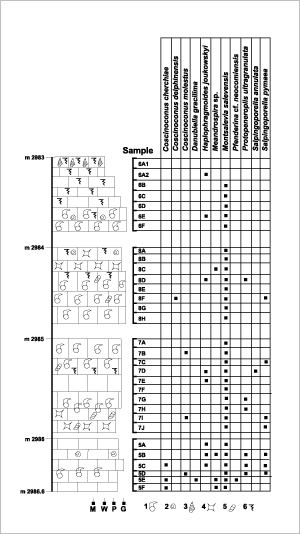
Click on thumbnail to enlarge the image.
Figure 2: Limestone succession from the borehole
studied showing the stratigraphic position of significant microfossils.
M,
mudstone; W, wackestone ; P, packstone ; G, grainstone; 1, rudists; 2, gastropods undifferentiated; 3, nerineid
gastropods; 4, echinoid fragments; 5, calcareous algae; 6. diaclases filled
with terrigenous material and reddish-brown matrix.
Dolomitic rocks, consisting of medium to coarsely crystalline dolosparite, were sampled between 3470 and 3476 m. The pre-existing carbonate sediment underwent intense dolomitization, as evidenced by the presence of only a few undolomitized bioclasts in the thin sections studied. The shape of the dolomite crystals varies from anhedral to euhedral rhombs. Many crystals display zonation with dark cores and pale rims. Sparry calcite cement subsequently filled the empty pores within the dolomitized fabrics. Locally, the rock has a brecciated appearance due to a system of small fractures.
The vertical distance between the dolomite and the limestone samples is 487 m. The limestone samples originate from the interval between 2983 and 2986.54 m.
A
relatively homogenous microfacies characterizes the entire studied interval.
Peloidal-skeletal grain-packstones are dominant (Fig.
3.A ![]() ;
Pl. 1.A-B
;
Pl. 1.A-B ![]() ),
with peloids most likely formed by micritization of foraminifer, bivalve, rare
echinoid and gastropod bioclasts (Pl.
1.D
),
with peloids most likely formed by micritization of foraminifer, bivalve, rare
echinoid and gastropod bioclasts (Pl.
1.D ![]() ),
as well as dasycladalean algae. Some intervals contain numerous small rudists (Figs. 2
),
as well as dasycladalean algae. Some intervals contain numerous small rudists (Figs. 2 ![]() - 3.B
- 3.B ![]() ;
Pl. 1.C
;
Pl. 1.C ![]() ), often associated with
Bacinella-type structures, Lithocodium
and microbial crusts.
), often associated with
Bacinella-type structures, Lithocodium
and microbial crusts.
This
microfacies grades up into packstone with voids
filled by a reddish-brown matrix with fine silt- and sand-size quartz grains (Fig. 3.C-D ![]() ; Pl. 1.E-G
; Pl. 1.E-G ![]() ).
Often the clasts are recrystallized
(Pl. 1.G
).
Often the clasts are recrystallized
(Pl. 1.G ![]() ). In some voids, the
reddish-brown matrix displays laminition (Pl. 1.H
). In some voids, the
reddish-brown matrix displays laminition (Pl. 1.H ![]() ).
).
The
top 20-25 cm of the interval studied is fenestral skeletal wackestone with nerineid
gastropods, miliolids and other small foraminifera, and voids filled with reddish-brown
silt (Pl. 1.H ![]() ); in some cases,
diaclases are filled with sand-size quartz grains embedded in silty matrix. The nerineid gastropods
suggest a partially restricted environment.
); in some cases,
diaclases are filled with sand-size quartz grains embedded in silty matrix. The nerineid gastropods
suggest a partially restricted environment.
It is noteworthy
that fissures filled with quartz and reddish-brown matrix occur at 2985.3 m
(sample 7D), 2984.3 m and 2984.7 m (samples 8D and 8A; Fig. 2 ![]() );
nevertheless, they become significant towards the top of the sampled
interval. The skeletal packstone-grainstone identified in the lower part of
the succession formed in a high-energy normal marine subtidal
environment. The middle part of the interval is characterized by skeletal intraclastic packstone-grainstone with rudists, foraminifers,
rivulariacean cyanobacteria, gastropods and ostracods. It likely formed
in a moderate- to high-energy subtidal environment. The fenestral skeletal packstones and
wackestones at the top of the succession indicate a very shallow subtidal to
intertidal environment, locally restrictive, characterized by reduced water
circulation.
);
nevertheless, they become significant towards the top of the sampled
interval. The skeletal packstone-grainstone identified in the lower part of
the succession formed in a high-energy normal marine subtidal
environment. The middle part of the interval is characterized by skeletal intraclastic packstone-grainstone with rudists, foraminifers,
rivulariacean cyanobacteria, gastropods and ostracods. It likely formed
in a moderate- to high-energy subtidal environment. The fenestral skeletal packstones and
wackestones at the top of the succession indicate a very shallow subtidal to
intertidal environment, locally restrictive, characterized by reduced water
circulation.
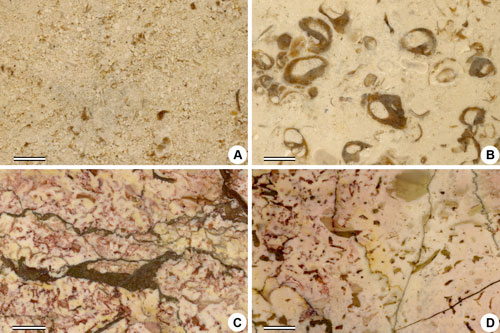
Click on thumbnail to enlarge the image.
Figure 3: Core-slab photographs of characteristic microfacies. A) peloid-skeletal grainstone; sample 7G. B) peloid-skeletal grainstone-packstone with rudists; sample 7B. C) skeletal wacke-packstone; diaclases filled with silty terrigenous material; sample 6B; D) fenestral skeletal wackestone; geopetal reddish-brown sediment infilling fenestrae; sample 6A. Scale bar 1 cm.

Click on thumbnail to enlarge the image.
Plate 1: A-B) peloid-skeletal grainstone with benthic foraminifera, bivalve and echinoderm fragments; sample 5F(A) and 7I(B). C) peloid-skeletal grainstone with rudists. Voids filled with silty matrix; sample 7E. D) peloid-skeletal packstone with fragments of rudists and gastropods; sample 8A. E-H) skeletal wackestone and wacke-packstone; diaclases filled with terrigenous material (sand-size quartz) and reddish-brown silty material; occasionally the clasts are recrystallized (G); silty sediment filling some voids displays a laminited structure (H). Scale bar 1 mm.
The dolomitic rocks from the borehole studied are identical with the dolomites identified in the borehole 6042 Deleni ( et al., 2004). Based on the identification of the foraminifer Redmondoides lugeoni, these can be assigned to the Late Jurassic.
A
micropaleontological assemblage dominated by foraminifera characterizes the
limestone samples collected from depths between 2983 and 2986.6 m: Montsalevia salevensis ( et al.)
(Pl. 2.A-I ![]() ;
Pl. 3.G
;
Pl. 3.G ![]() ), Haplophragmoides
joukowskyi et al.
(Pl. 3.A-E, G
), Haplophragmoides
joukowskyi et al.
(Pl. 3.A-E, G ![]() ), Haplophragmoides sp.,
Protopeneroplis ultragranulata () (Pl.
3.F
), Haplophragmoides sp.,
Protopeneroplis ultragranulata () (Pl.
3.F ![]() ;
Pl. 4.A
;
Pl. 4.A ![]() ),
Siphovalvulina
sp. (Pl. 3.H
),
Siphovalvulina
sp. (Pl. 3.H ![]() ), Danubiella gracilima
(Pl. 3.I
), Danubiella gracilima
(Pl. 3.I ![]() ), Ammobaculites sp.,
Coscinoconus molestus () (Pl. 4.B-D
), Ammobaculites sp.,
Coscinoconus molestus () (Pl. 4.B-D ![]() ),
C.
cherchiae ( et
al.) (Pl. 4.E, G
),
C.
cherchiae ( et
al.) (Pl. 4.E, G ![]() ;
Pl. 5.C
;
Pl. 5.C ![]() ),
C. delphinensis (
et al.) (Pl. 4.H
),
C. delphinensis (
et al.) (Pl. 4.H ![]() ), Bolivinopsis sp., Charentia sp.
(Pl. 5.A
), Bolivinopsis sp., Charentia sp.
(Pl. 5.A ![]() ), Earlandia? conradi
, Gaudryina sp., Lenticulina sp.,
Meandrospira sp., Mayncina
sp., ?Mesoendothyra sp., Nautiloculina
sp., Patelovalvulina sp., Pfenderina
cf. neocomiensis (),
Praechrysalidina sp., Pseudocyclammina
sp., Scythiolina/Vercorsella
sp., and Troglotella incrustans
& (Pl. 5.B
), Earlandia? conradi
, Gaudryina sp., Lenticulina sp.,
Meandrospira sp., Mayncina
sp., ?Mesoendothyra sp., Nautiloculina
sp., Patelovalvulina sp., Pfenderina
cf. neocomiensis (),
Praechrysalidina sp., Pseudocyclammina
sp., Scythiolina/Vercorsella
sp., and Troglotella incrustans
& (Pl. 5.B ![]() ). Rare
calcareous algae [Salpingoporella pygmaea ()
(Pl. 5.D-F
). Rare
calcareous algae [Salpingoporella pygmaea ()
(Pl. 5.D-F ![]() ), S. annulata
(Pl. 5.G
), S. annulata
(Pl. 5.G ![]() ), Thaumatoporella
parvovesiculifera (), and
"Solenopora" sp.], rivulariacean
cyanobacteria (Pl. 5.H
), Thaumatoporella
parvovesiculifera (), and
"Solenopora" sp.], rivulariacean
cyanobacteria (Pl. 5.H ![]() ), Lithocodium
aggregatum and Bacinella-type structures are also present.
), Lithocodium
aggregatum and Bacinella-type structures are also present.
From a biostratigraphic point of view, the most significant species in this assemblage
are Haplophragmoides joukowskyi,
Montsalevia salevensis and Protopeneroplis
ultragranulata. Montsalevia salevensis
dominates the assemblages, being present in almost all the studied samples (Fig. 2 ![]() ).
The above three species have often been noted in Upper Berriasian-Valanginian
deposits (e.g., , 1983;
et al., 1984; ,
1987; , 1988; ,
1991;
& , 1991; et
al., 1994; , 1995;
et
al., 1995; & ,
1998;
& , 1999; & ,
2006;
& , 2006; & ,
2010;
& , 2011). Accordingly, we consider that the similar assemblages
and facies from the borehole studied can be assigned to the same stratigraphic
interval. The foraminiferal assemblage with Coscinoconus (C. cherchiae,
C. delphinensis, C. molestus) additionally points to a Berriasian-Valanginian
age ( et al., 1988; ,
1994; et
al., 1995; & ,
1999; et
al., 2013).
).
The above three species have often been noted in Upper Berriasian-Valanginian
deposits (e.g., , 1983;
et al., 1984; ,
1987; , 1988; ,
1991;
& , 1991; et
al., 1994; , 1995;
et
al., 1995; & ,
1998;
& , 1999; & ,
2006;
& , 2006; & ,
2010;
& , 2011). Accordingly, we consider that the similar assemblages
and facies from the borehole studied can be assigned to the same stratigraphic
interval. The foraminiferal assemblage with Coscinoconus (C. cherchiae,
C. delphinensis, C. molestus) additionally points to a Berriasian-Valanginian
age ( et al., 1988; ,
1994; et
al., 1995; & ,
1999; et
al., 2013).

Click on thumbnail to enlarge the image.
Plate 2: A-I) Montsalevia salevensis ( et al.); subaxial (A, H), longitudinal-tangential (B-D, F), axial (E), and transverse (G, I) sections. A) sample 6E; B, G) sample 8A; C) sample 7D; D) sample 7E; E, I) sample 5A; F) sample 5B; H) sample 6F. Scale bar 0.25 mm.
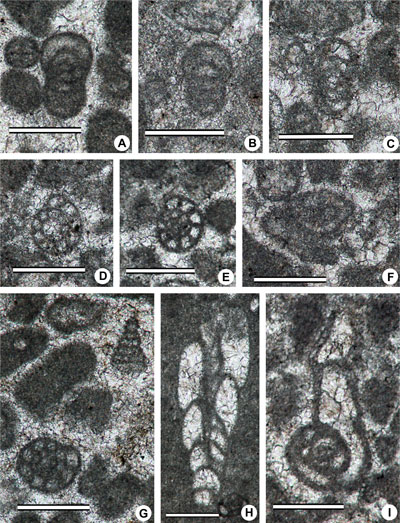
Click on thumbnail to enlarge the image.
Plate 3: A-E, G lower-left) Haplophragmoides joukowskyi et al.; axial-subaxial (A-C, G lower-left) and equatorial (D-E) sections. F) Protopeneroplis ultragranulata (); subaxial section. G upper-right) Montsalevia salevensis ( et al.); longitudinal-tangential section. H) Siphovalvulina sp.; longitudinal section. I) Danubiella gracilima (); longitudinal section. A) sample 6E; B, F) sample 5B; C, E) sample 7D; D) sample 8D; G) sample 8A; H) sample 6A1; I) sample 5E. Scale bar 0.25 mm.
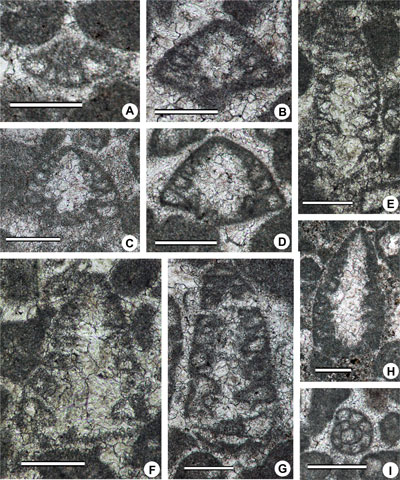
Click on thumbnail to enlarge the image.
Plate 4: A) Protopeneroplis ultragranulata (); subaxial-oblique section. B-D) Coscinoconus molestus (); longitudinal section. E, G) C. cherchiae ( et al.); longitudinal sections. F) Coscinoconus sp.; longitudinal section. H) C. delphinensis ( et al.); longitudinal section. I) ?Haplophragmoides sp. Equatorial, slightly oblique section. A) sample 5B; B) sample 5D; C) sample 7I; D) sample 7B; E, G) sample 5F; F) sample 5E; H) sample 8F; I) sample 6F. Scale bar 0.25 mm.
The
sedimentary formations from the basement of the Transylvanian Depression have
been correlated with similar units from Southern Apuseni Mountains (
et al., 1970;
& , 1978; ,
1984; et
al., 2004). &
(2005a, 2005b) described shallow-marine carbonate rocks containing similar microfossil assemblages from the Trascău Mountains. Diverse
calcareous algae and foraminiferal assemblages are known from the
Berriasian-Valanginian of the Hăghimaş Nappe of the Eastern
Carpathians (, 1975,
2011; & ,
2011) including Montsalevia
salevensis and Haplophragmoides
joukowskyi (, unpublished). These two foraminifera were also
identified in the Upper Berriasian-Lower Valanginian limestones immediately
below a
major intra-Valanginian unconformity from the Dâmbovicioara region and south of
Codlea, Southern Carpathians ( & ,
1999; et al., 2011;
et al., 2013). Unfortunately, no
obvious unconformity could be found in the succession studied.
Nevertheless, the presence of fissures and voids filled with terrigenous
material
(Pl. 1.F-G ![]() ), often reddish-brown
in color, may suggest that the
limestones studied could occur not very far below such an unconformity.
), often reddish-brown
in color, may suggest that the
limestones studied could occur not very far below such an unconformity.
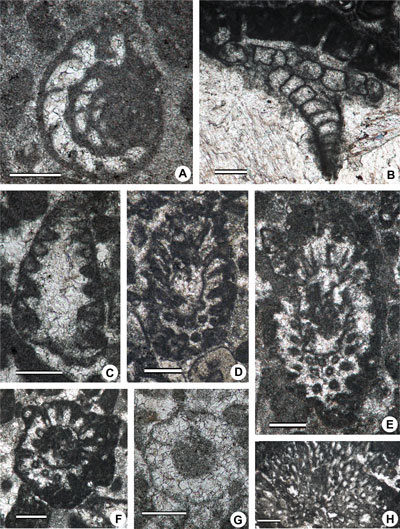
Click on thumbnail to enlarge the image.
Plate 5: A) Charentia sp.; equatorial section. B) Troglotella incrustans & ; longitudinal section. C) Coscinoconus cherchiae ( et al.); longitudinal section. D-F) Salpingoporella pygmaea () sp. ; oblique (D-E) and transverse (F) sections. G) Salpingoporella annulata ; transverse section. H) rivulariacean-type cyanobacteria; oblique section. A) sample A; B) sample 7H; C) sample 5C; D) sample 5B; E-F) sample 7J; G) sample 8F; H) sample 6B. Scale bar 0.25 mm.
Carbonate rocks sampled from a borehole drilled near Târnăveni in the Transylvanian Depression, Romania, contain a distinctive microfossil assemblage with Haplophragmoides joukowskyi, Montsalevia salevensis and Protopeneroplis ultragranulata, which is characteristic for an upper Berriasian-Valanginian age. This assemblage represents the first evidence for the presence of lowermost Cretaceous carbonate deposits in the basement of the Transylvanian Depression. The limestones studied formed in a peritidal setting on the Transylvanian shallow carbonate platform.
This work represents a contribution to the research project financed by the CNCS PN-II-ID-PCE-2011-3-0025 grant. We thank the three reviewers, Felix , Danielle and Antun for their remarks and the suggested corrections which helped to improve the paper. We also thank Robert for corrections of the English.
D. (1991).- Microfossil biostratigraphy (mainly foraminifers) of the Jurassic-Lower Cretaceous carbonate succession in north-western Anatolia (Turkey).- Geologica Romana, Roma, vol. 27, p. 167-213.
D. & S. (1991).- Calpionellid zonation in north-western Anatolia (Turkey) and calibration of the stratigraphic ranges of some benthic foraminifera at the Jurassic-Cretaceous boundary.- Geologica Romana, Roma, vol. 27, p. 215-235.
A., T. & C. (1988).- Le genre Trocholina 1922 et ses principales espèces au Crétacé.- Revue de Paléobiologie, Genève, Vol. spéc. nº 2 (Benthos '86), p. 353-377.
E. & E. (1999).- A peculiar Upper Valanginian cephalopod fauna from the Carpathian Bend (Codlea Town area, Romania): biostratigraphic and paleobiogeographic implications.- Jahrbuch der Geologischen Bundesanstalt, Wien, Band 136, Heft 4, p. 665-700.
E. (1995).- Transect plate-forme_bassin dans les séries carbonatées du Berriasien supérieur et du Valanginien inférieur (Domaines jurassien et nord-vocontien). Chronostratigraphie-transferts des sédiments.- Géologie Alpine, Grenoble, Mémoire H.S. nº 25, 312 p.
I.I. (1988).- Les foraminifères du Crétacé inférieur (Berriasien-Valanginien) de la zone de Reşiţa-Moldova Nouă (Carpathes Méridionales, Roumanie). Remarques biostratigraphiques.- Revue de Paléobiologie, Genève, Vol. spéc. nº 2 (Benthos '86), p. 379-389.
I.I., M.A. & R. (1995).- Foraminifers and calcareous algae from Valanginian limestones in the Jerma River canion, Eastern Serbia.- Revue de Paléobiologie, Genève, vol. 14, nº 2, p. 349-377.
I.I., M.-A. & E. (2004).- The Mesozoic carbonate deposits from the borehole 6042 Deleni (Transylvanian Depression).- Studia UBB Geologia, Cluj-Napoca, vol. 59, nº 2, p. 27-48.
I.I. & E. (2005a).- Micropaleontological assemblages from the Upper Jurassic-Lower Cretaceous deposits of Trascău Mountains and their biostratigraphic significance.- Acta Palaeontologica Romaniae, Cluj-Napoca, vol. 5, p. 27-38.
I.I. & E. (2005b).- Relationship between algae and environment: an Early Cretaceous case study, Trascău Mountains, Romania.- Facies, Erlangen, vol. 51, p. 274-286.
I.I. & E. (2011).- Upper Jurassic-Lower Cretaceous algae of Hăghimaş Mountains (Lacul Roşu-Cheile Bicazului area). In: I.I. & E. (eds.), Calcareous algae from Romanian Carpathians.- Field trip guidebook, 10th International Symposium on Fossil Algae (Cluj-Napoca, 12-18 September 2011), p. 57-96.
I.I., E., I., O.N. & M. (2011).- Mesozoic deposits of the Dâmbovicioara couloir. In: I.I. & E. (eds.), Calcareous algae from Romanian Carpathians.- Field trip guidebook, 10th International Symposium on Fossil Algae ( Cluj-Napoca, 12-18 September 2011), p. 23-31.
M., A., A., V. & M. (1994).- Biostratigrafia a foraminiferi, dasicladali e calpionelle delle successioni carbonatiche mesozoiche dell'Appennino centrale (Italia).- Studi Geologici Camerti,Camerino, volume speciale "Biostratigrafia dell'Italia centrale", p. 9-128.
D., M. & (1970).- Geology of the Transylvanian Depression.- Editura Academiei RPR, Bucureşti, 256 p. [in Romanian]
C. (1983).- La plate-forme berriaso-valanginienne du Jura méridional aux massifs subalpins (Ain, Savoie). Sédimentologie, minéralogie, stratigraphie, micropaléontologie.- Thèse 3ème cycle, Université de Grenoble, 319 p.
O. (1975).- Upper Jurassic and Lower Cretaceous microfacies from the Bicaz Valley basin (East Carpathians).- Mémoires de l'Institut de Géologie et Géophysique, Bucarest, vol. 21, 87 p.
O. (2011).- Early Cretaceous foraminifera, algal nodules and calpionellids from the Lapoş Valley, Bicaz Gorges (Eastern Carpathians, Romania).- Analele ştiinţifice ale Universităţii "Al. I. Cuza" din Iaşi, Iaşi, ( seria Geologie), vol. 57, nº 1, p. 91-113.
S. & M.A. (2008).- Paleocene deep-water agglutinated Foraminifera in the Transylvanian Basin. In: M.A., R. & A. (eds.), Proceedings of the Seventh International Workshop on Agglutinated Foraminifera.- Grzybowski Foundation, London, Special Publication 13, p. 25-30.
M., I., I.I., M.N., E. & A. (2013).- From subaerial exposure to the drowning of the Getic carbonate platform – evidences of Early Cretaceous global crisis in South Carpathians (Dâmbovicioara zone, Romania). In: D. (ed.), Ninth Romanian Symposium on Paleontology (Iasi, 25-26 October 2013).- Abstract Book, Iaşi, p. 94-95.
B. (1987).- Le Crétacé inférieur de la Costa Blanca entre Busot et Altea, Alicante (Espagne) : Biostratigraphie, Sédimentologie, Evolution tectono-sédimentaire.- Thèse, Docteur de l'Université Paris VI (nouveau régime), 23 Novembre 1987; Mémoires des Sciences de la Terre, Université Pierre et Marie Curie, Paris, 87-49, vol. I (texte): 281 p.; vol. II (54 Pls.).
B. & I. (2011).- Stratigraphic ranges of some Tithonian-Berriasian benthic foraminifers and Dasycladales. Re-evaluation of their use in identifying this stage boundary in carbonate platform settings. In: D., B. & N. (eds.), Platform to basin correlations in Cretaceous times.- Boletín del Instituto de Fisiografía y Geología, Rosario, vol. 79-81, p. 9-10.
A. & B. (2006).- Early Cretaceous benthic associations (foraminifera and calcareous algae) of a shallow tropical-water platform environment (Milet Island, southern Croatia).- Cretaceous Research, London, vol. 27, p. 418-441.
C., V., C., F., I. & L. (2009).- New insights into the basement of the Transylvanian Depression (Romania).- Lithos, Amsterdam, vol. 108, p. 172-191.
D. & B. (2010).- Late Jurassic-Early Cretaceous foraminifera from Štramberk-type limestones, Polish Outer Carpathians.- Studia UBB Geologia, Cluj-Napoca, vol. 55, nº 2, p. 3.
C. & A.V. (2006).- The Transylvanian Basin (Romania) and its relation to the Carpathian fold and thrust: insights in gravitational salt tectonics.- Marine and Petroleum Geology, Amsterdam, vol. 23, p. 405-442.
A. & B. (1999).- Le Trocholine dei sedimenti mesozoici di piattaforma carbonatica dell'Appennino centro-meridionale (Abruzzo e Lazio).- Revue de Paléobiologie, Genève, vol. 18, nº 1, p. 147-171.
T. (1994).- Early Cretaceous Trocholina group and some related genera from Romania. Part I.- Revista Española de Micropaleontologia, Madrid, vol. 26, nº 3, p. 117-143.
D. (1975).- Geology of the Hydrocarbon ore deposits from Romania.- Studii Tehnice şi Economice, seria A - Prospecţiuni şi explorări geologice, Bucureşti, nº 10, 363 p. [in Romanian]
D. (1979).- Romanian oil and gas fields.- Technical and Economical Studies, Bucharest, (A series - Geological Prospecting and Exploration), nº 13, 382 p.
I. & D. (1967).- Contribution to the study of the pre-Tortonian in the Transylvanian Depression.- Carpatho-Balkan Geological Association, VIII Congress (Belgrade, Septembre 1967), Reports, Stratigraphy, p. 427-432.
B., J., R. & R. (2013).- Taxonomy and phylogeny of the Trocholinidae (Involutinina).- Journal of Foraminiferal Research, Lawrence, vol. 43, nº 4, p. 317-339.
B. & D. (1998).- Middle Jurassic-Lower Cretaceous biostratigraphy in the Central Pontides (Turkey): remarks on paleogeography and tectonic evolution.- Rivista Italiana di Paleontologia e Stratigrafia, Milano, vol. 104, nº 2, p. 167-180.
G., L. & J. (1984).- Les foraminifères dans le Crétacé inférieur (Berriasien moyen-Valanginien inférieur) de la région de la Corraterie, Grand-Salève (Haute-Savoie, France) : inventaire préliminaire et remarques stratigraphiques.- Revue de Paléobiologie, Genève, vol. 3, nº 2, p. 175-184.
M. (1984).- Geotectonics of Romania.- Editura Tehnică, Bucureşti, 336 p. [in Romanian]
M. & M. (1978).- Considérations sur la structure tectonique du soubassement de la Dépression de Transylvanie.- Dări de Seamă ale Şedinţelor, Bucureşti, (Tectonică şi geologie regională), vol. 64, nº 5, p. 153-173.
F. & O. (1999).- New results on microfacies, biostratigraphy and sedimentology of Late Jurassic-Early Cretaceous platform carbonates of the Northern Calcareous Alps. Part 1: Tressenstein Limestone, Plassen Formation.- Abhandlungen der Geologischen Bundesanstalt, Wien, vol. 56, nº 2, p. 379-418.
F. & H.-J. (2006).- "Subdelloidina" luterbacheri 1987 (encrusting Foraminifera) from Late Jurassic to Early Cretaceous reefal limestones of Albania and the Northern calcareous Alps (Austria).- Jahrbuch der Geologischen Bundesanstalt, Wien, vol. 146, nº 1-2, p. 53-63.
I. (2007).- Stratigraphy and Palaeobiogeography of Mesozoic benthic foraminifera of the Karst Dinarides (SE Europe).- Geologia Croatica, Zagreb, vol. 60, nº 1, p. 1-113.